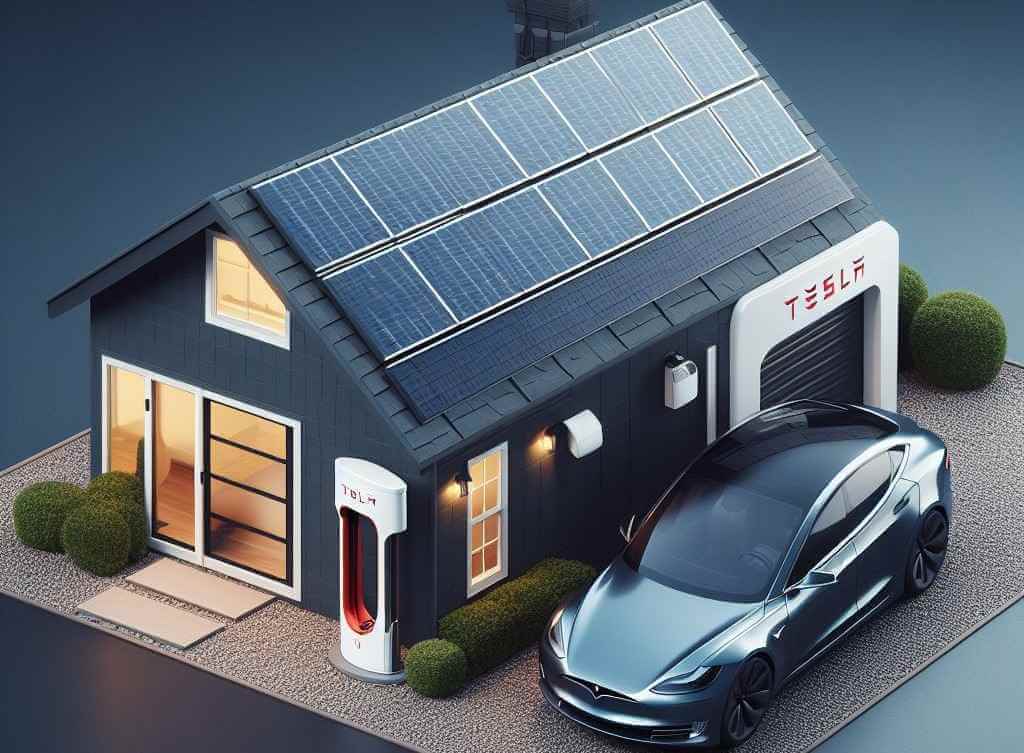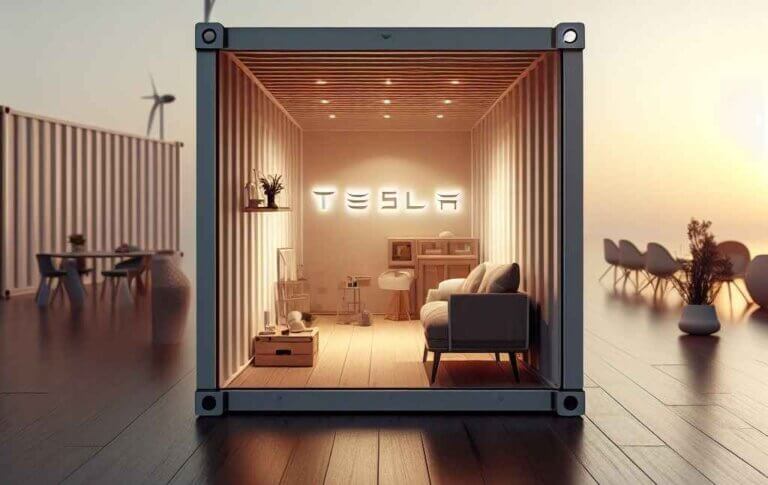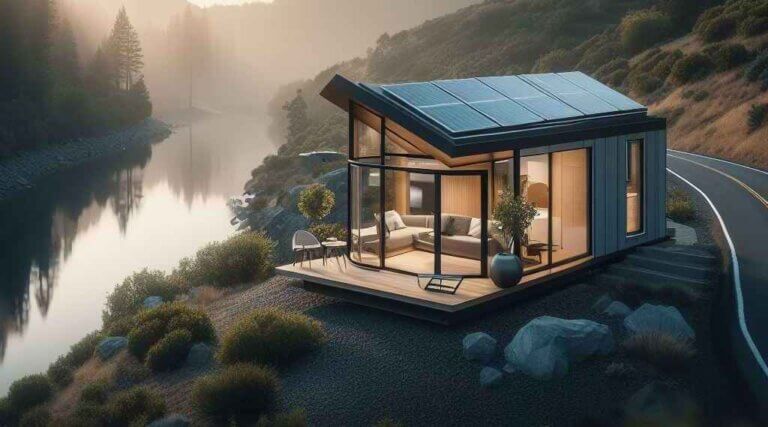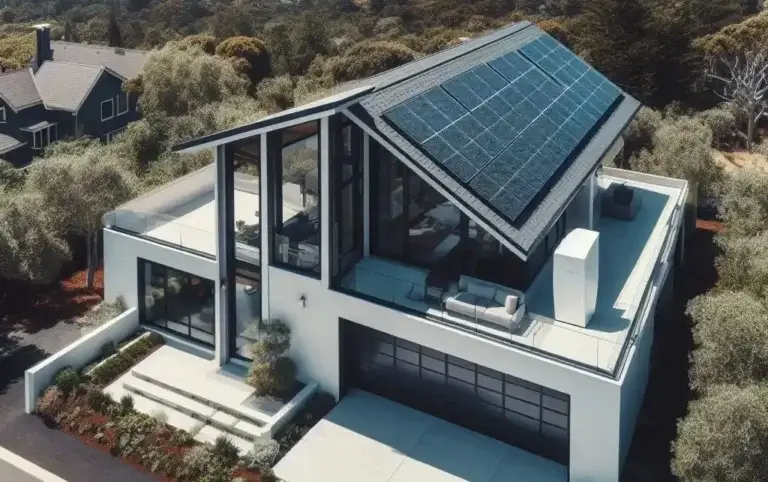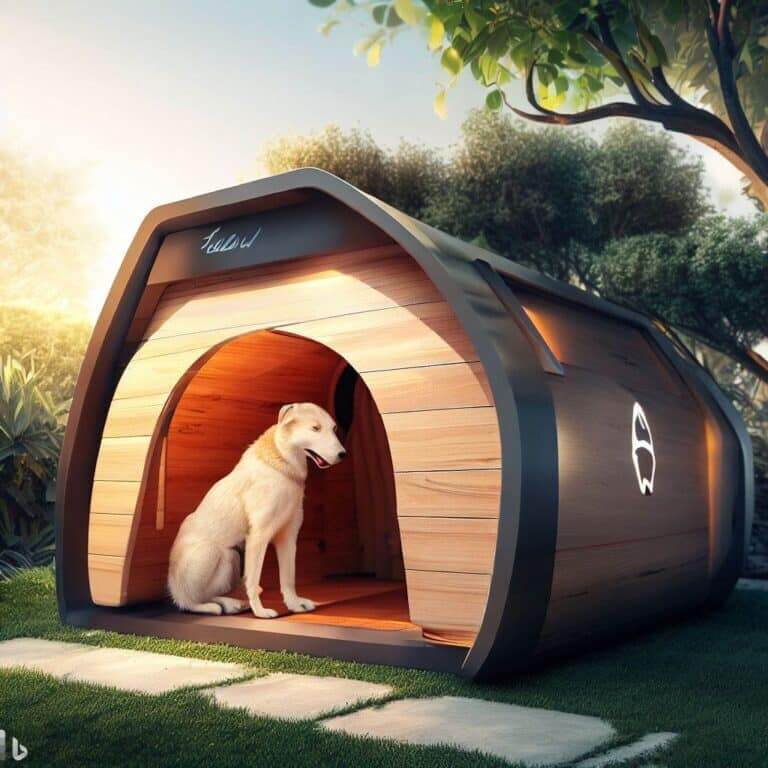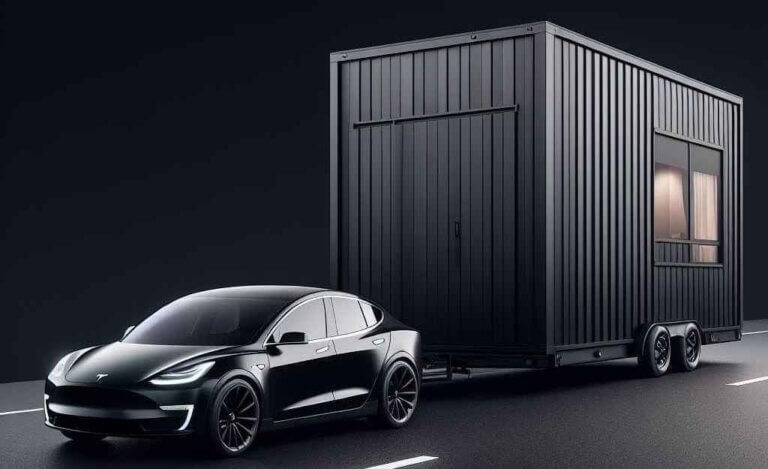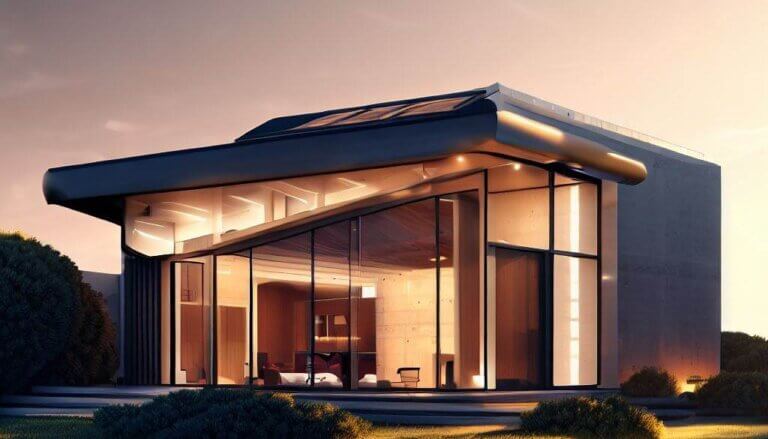Tesla Solar Panels on Metal Roof: Everything You Need to Know Before Going Solar in 2024
Are you considering installing Tesla solar panels on metal roof? With rising energy costs, more homeowners are looking to solar power to save money while helping the environment.
Installing Tesla solar panels on a metal roof can be an excellent choice, but it’s important to understand the specifics when it comes to compatibility, mounting systems, costs, production efficiency, and more.
In this comprehensive guide, we’ll cover all the key considerations, questions, and details you’ll need to know before moving forward with Tesla solar panels on metal roof systems from Tesla Energy.
Table of Contents
What Type of Metal Roof is Best for Solar Panels?
When evaluating putting solar panels on metal roofs, the first step is understanding your current roof type and material. The most common options include:
- Standing seam metal roof – This type of metal roofing has raised seams where panels interlock. It’s durable, long-lasting, and provides an excellent mounting surface for solar panels using seam clamps.
- Corrugated metal roof – Made of galvanized steel or aluminum, this ribbed metal roof also works well for solar with some considerations around sealing and flashing.
- Metal shingles or tiles – Solar can be installed on these with additional substructures, but integrated solar roofs may be easier.
Get up in your attic or climb a ladder to visually inspect your exact metal roof style if unsure. This will dictate the best mounting approach. Beyond material, key factors are roof age, expected longevity, conditions, and exposure to sun.
Speak with a Tesla solar advisor or installer to evaluate if your existing metal roof is suitable for solar or if you need a roof replacement first.
Can Tesla Solar Panels Be Installed on a Metal Roof?
The short answer is yes. With a standing seam metal roof or certain corrugated styles, Tesla solar panels can be mounted using reputable, non-penetrating attachment methods.
Tesla’s solar panels use durable tempered glass and are designed to withstand harsh weather conditions including hail, high winds, storms, and more. This makes them well-suited for pairing with metal roofing which shares similar resilience.
Some key advantages to installing Tesla solar panels on a metal roof include:
- Long system lifespans – With 30+ year solar panel warranties and 50+ year metal roof expectancies, the systems can last together for decades.
- Minimal roof impacts – Non-penetrating S-5 clamps secure solar but don’t compromise the roof.
- Sleek aesthetic – The industrial look of solar complements modern metal architectural styles nicely.
- Enhanced energy production – Reflective metal roofs can increase solar output compared to shingles.
- Durable materials – Metal and tempered glass both stand up well to hail, wind and weather over decades.
As long as your roof framing can support the additional weight and meet other structural requirements, Tesla Solar paired with a standing seam metal roof, corrugated metal, or certain metal shingles can make an excellent combination for maximum energy production and savings over the systems’ lifetimes.
What is the Best Mounting System for Solar Panels on a Metal Roof?
Installing solar panels involves securely attaching supports, racks, and frames with the right mounting system for your specific roof type.
For metal roofs, panel mounting best practices include using non-penetrating S-5 clamps or seam hooks paired with attachment beams that align with the panel frames.
S-5 clamps attach to the raised seams of standing seam metal roofing without compromising water shedding or the protective finishes. And seam hooks physically wrap around the seam edges.
These non-penetrating mounting systems require no drilling or holes in the metal roof, maintaining structural integrity, weather-sealing, and manufacturers’ warranties.
Beyond S-5 clamps and seam hooks, additional railings, flashing, and structural components complete the solar mounting system and properly elevate the panels while also preventing leaks or drips into the home.
Tesla offers certified installers who are experts in solar panel mounting practices for all common roof types including metal. Be sure to inquire about their experience and examples of past metal roof solar installations when evaluating installers. This helps ensure proper mounting for your specific panels and seam style while preserving roof performance.
Do Solar Panels on Metal Roofs Need to Be Attached Differently Than on Shingle Roofs?
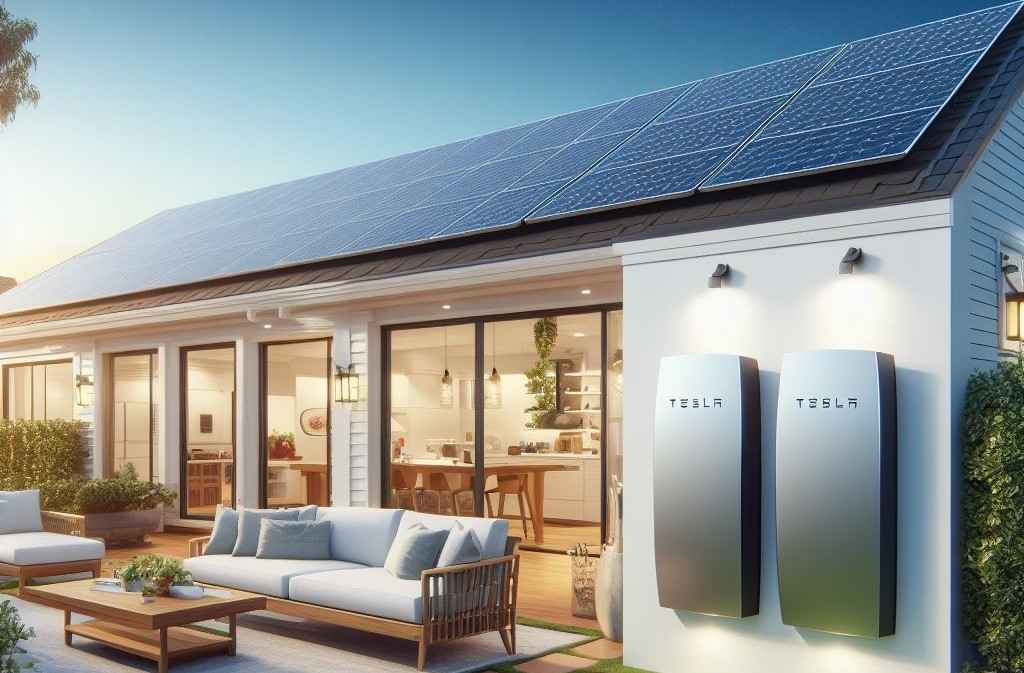
Yes, best practices for mounting solar panels on metal roofs differ from attachments on asphalt or tile shingle roofing.
Whereas solar can be anchored using roof-penetrating lag bolts on shingle roofs, different methods are required for metal roofs to avoid holes, leaks or voids in important weatherproofing elements.
As covered already, standing seam metal panels allow for durable S-5 clamps secured to raised seams above the water line without compromising the roof. This method leaves no penetrations or damage.
For ribbed or exposed-fastener metal roofing, seam clamps are not always possible. So substructures with adhesive padding or rubber membranes provide protective barriers while still avoiding roof perforations.
When solar mounts to metal shingles, additional beams may be needed under panels for proper weight distribution and avoidance of cracks or breakages in brittle metal tiles.
So in summary – yes, the specific mounting and attachment systems do differ:
- Asphalt shingle roof: Lag bolts secure solar racks directly into roof decking
- Standing seam metal roof: S-5 clamps attach solar rails to raised seams
- Corrugated metal roof: Substructures disperse weight between panels across the roofing surface
- Metal shingles: Robust mounting frames prevent crack or damage in tiles
Be sure your installer follows best practices for your exact metal roof type when securing solar panel positioning.
Do Solar Panels Damage Metal Roofs?
When properly designed and installed, reputable solar mounts do not damage metal roofs. As explained already, S-5 clamps for standing seam applications secure panels without penetrating the water-shedding roof components or protective coatings.
Likewise, substructure mounts for corrugated or metal shingle roofing prevent excess weight or force from impacting roof materials when properly distributing the load.
However, lower-quality mounting equipment lacking proper padding or adaption to the roof profile can result in abrasion, distortions, or cracks over time. And penetrations left unsealed could eventually lead to leaks or corrosion.
So it is essential homeowners vet their installer, ensure non-penetrating or well-sealed attachments, and get documentation on warranties as well as maintenance obligations related to the mounting system.
With quality solar installation using reputable, roof-specific equipment, panels enhance rather than compromise metal roof performance and longevity. Monitoring and upkeep of mounts do remain important over decades of operation.
Will Solar Panels Affect My Metal Roof Warranty?
This depends on your specific metal roof manufacturer warranty fine print. Many do allow non-penetrating solar attachments without voiding coverage. However, adding electrical components can impact fire ratings or wind/weather allowances if applicable.
Review warranty details closely and check directly with your roofer before installing solar. Key considerations often include:
- Date of installation – Older roofs may be dated out of warranty coverage already
- Approved mounting methods – Confirm seam clamps, and substructures are acceptable
- Roof penetrations – Holes often violate warranties so prefer non-penetrating
- Wind resistance – Attachments may impact structure ratings
- Fire resistance – Electrical parts influence fireproof design spec compliance
- Weight limits – Confirm roof structure and framing can support panels
Ideally, the roof and solar system warranties run concurrently, both covering 20-30 years from the initial solar installation date.
If warranty compromises are a concern, a new metal roof installed simultaneously with the Tesla solar system may provide the simplest and most comprehensive coverage.
How Much Do Tesla Solar Panels on a Metal Roof Cost?
Tesla solar panels paired with a standing seam metal roof offer homeowners excellent long-term value through low-cost solar energy production for decades. However, exact pricing varies significantly based on your unique roof size, panel system requirements, and financing or incentive options available.
Ballpark costs when adding Tesla solar panels to an existing metal roof often fall between $15,000 – $35,000 before tax credits or other incentives. Financing as low as $100 per month is accessible to many homeowners as well.
Some key cost factors include:
- Roof type and age – A replacement roof raises costs more than using suitable existing metal roofing
- Roof size and pitch – More complex roofs require more custom mounts, parts, and labor
- Number of panels – Solar array system size correlates directly to the overall price
- Electrical upgrades – Any required line, meter, panel, or conduit upgrades add expense
- Permits and structural assessments – Ensure code compliance
- Installer pricing – Get multiple quotes for your exact property specs
Also, factor available federal tax credits, local utility rebates, solar renewable energy credits (SRECs), property tax exemptions, and financing options when budgeting your out-of-pocket solar project costs.
The long-term energy bill savings from adding solar to a metal roof make this a sound, profitable investment over decades of zero-fuel electricity production from the sun.
Can I Install Tesla Solar Tiles on My Metal Roof?
Tesla solar tiles integrate solar collection technology directly into durable glass roofing tiles with integrated weatherproofing elements. However, these tiles cannot overlay existing roof decking.
Instead, Tesla solar tiles entail a complete roof tear-off and replacement to install the Tesla roof system over new waterproof membranes and framing.
So Tesla solar tiles do not mount onto or work in conjunction with your existing metal roof. To benefit from the tiles, you would essentially install a brand new Tesla ‘solar roof’ system to entirely replace your current standing seam, corrugated or metal shingle roof.
While the Tesla solar tile roof delivers excellent efficiency and longevity, the high costs of full roof replacement are inhibitive for some homeowners.
Adding Tesla solar panels to well-suited existing metal roofs provides a more affordable alternative with comparable benefits and system lifespan.
Carefully weigh the costs and benefits of both options in your situation if considering switching to a Tesla solar roof.
Tesla Solar Panels on Metal Roof
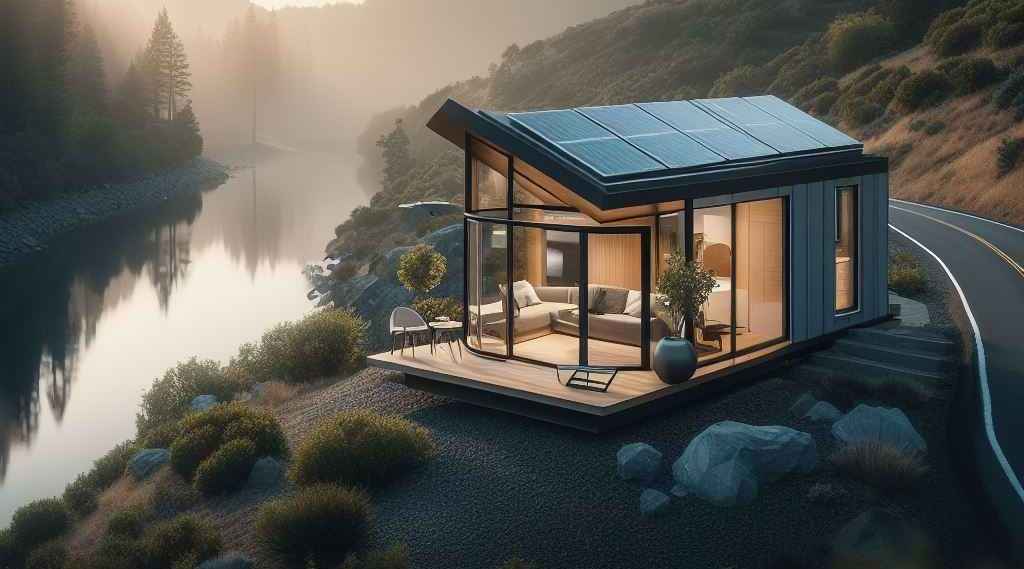
Whether you can install Tesla solar panels on your metal roof depends on the type of metal roof you have and Tesla’s current policies. Here’s a breakdown:
Compatibility:
- Compatible roofs: Tesla generally works with standing seam, corrugated, and metal shingle roofs.
- Incompatible roofs: Tesla currently has limitations on installing on roofs with less than 14 degrees pitch or made of certain metals like copper or zinc.
Mounting options:
- Penetrating mounts: These traditional mounts secure the panels directly to the roof structure with screws or bolts, potentially compromising the roof’s integrity and waterproofing.
- Non-penetrating mounts: These newer systems clamp or hook onto the existing roof features without puncturing it, preserving the roof’s warranty and preventing leaks.
Current policy:
- Tesla Solar Panels: As of December 2023, Tesla has temporarily paused taking orders for traditional solar panel installations on metal roofs. This might be due to limitations of their current mounting system or a shift towards promoting their Solar Roof product.
- Tesla Solar Roof: This integrated solar and roofing system seamlessly replaces your existing roof with solar tiles, offering a more durable and aesthetically pleasing option. However, it’s significantly more expensive and has limited compatibility with certain metal roof types like corrugated roofs.
Here’s a quick summary:
| Feature | Traditional Tesla Solar Panels | Tesla Solar Roof |
|---|---|---|
| Compatibility | Most metal roofs (limitations exist) | Standing seam & metal shingle roofs only |
| Mounting | Penetrating or non-penetrating | Integrated into the roof structure |
| Current availability | Orders temporarily paused | Available for installation |
| Cost | More affordable | Significantly more expensive |
| Aesthetics | Less visually appealing | Sleek, modern look |
| Durability | Potentially less durable in extreme weather | More durable than traditional panels |
drive_spreadsheetExport to Sheets
Recommendation:
- Contact Tesla: Despite the temporary pause, reach out to Tesla to discuss your specific situation and get the latest information on their policies and available options.
- Explore alternatives: While Tesla might not be the best fit right now, consider contacting local solar installers who specialize in metal roof installations. They might offer compatible mounting systems and alternative solar panel options.
Remember, the best choice depends on your specific roof type, budget, and aesthetic preferences. Weigh the pros and cons of each option and get quotes from different providers before making a decision.
I hope this clarifies the situation and helps you find the best solar solution for your metal roof!
Can I Install Tesla Solar Panels on Corrugated Metal Roofs?
Yes, installing solar panels on corrugated metal roofs is possible using reputable mounting equipment properly suited for the unique shape and materials.
Key considerations for solar on corrugated metal include selecting flexible mounting components able to conform across the curved roof profile without excess or uneven weight distribution. This prevents roofing distortion over time.
Adhesive pads attach to corrugation troughs without penetrating fasteners, while elevated cross-beams align above seams to prevent water runoff barriers.
Flashing seals all attachment joints while allowing necessary panel tilts and angles.
For homeowners with corrugated metal roofing seeking solar installation, be sure to get experienced installer guidance assessing current roof condition and structure. Cooling solar efficiency technologies may also help limit the impacts of panel heat absorption on certain metal roof materials.
With careful design and adapting equipment created specifically for ribbed applications, durable corrugated steel or aluminum roofing provides an excellent platform for efficient Tesla solar energy production for decades to come.
17 Key Considerations Before Installing Tesla Solar Panels on a Metal Roof
Deciding whether to move forward with installing Tesla solar panels on an existing metal roof requires careful evaluation of many technical and financial factors unique to your home.
Below we break down 17 key considerations to understand and assess with roofing and solar professionals prior to making a full commitment:
1. Roof Age and Expected Lifespan
Consider current roof age, conditions, and realistic longevity to determine if replacement is needed before solar mounting. Target concurrent system expirations.
2. Roof Structure and Weight Capacities
Ensure roof framing and decking can support solar panels without compromise. Factor snow load weights as well.
3. Roof Warranty Impacts
Review the manufacturer’s warranty details and understand any voiding implications of solar installs.
4. Solar Production Efficiency Differences
Compare energy production data of panels on shingle vs metal roofs to model system output.
5. Leak and Drip Risk Mitigation
Eventually, all roofs leak, so mitigate the risk of solar attachments funneling water into the home with robust flashing.
6. Wind and Hail Resistance
Account for solar attachments’ impact on wind or hail ratings for roof structures and panels.
7. Fire Resistance and Electrical Considerations
Additional electrical roof components may impact fireproofing capacities or require upgraded electrical service panels.
8. Mounting Equipment Quality and Specs
Vet mounting component ratings, load tolerances, and weatherproof specs, matching to local climate reality.
9. Contractor Experience and Work Samples
Validate solar installer expertise specifically for metal roof applications with sample visuals from past clients.
10. Total Project Cost and Long Term Savings
Model 30+ year system cost projections contrasted against expected energy savings to demonstrate return on investment over time.
11. Financing and Incentive Options
Seek the most favorable loan terms and maximize tax credits, rebates, and other incentives to limit out-of-pocket costs.
12. HOA Rules or Compliance Issues
Carefully review any homeowners’ association regulations related to exterior remodels or roof solar installations before proceeding.
13. Maintenance Requirements and Costs
Understand both roofing and solar equipment needs for cleaning, upkeep, and component replacement over decades of operation.
14. Monitoring and Alert Systems
Consider automatic roof leak detection systems as added insurance against water intrusion over time.
15. Warranties and Coverage Considerations
Overlap new roof and solar warranties or extended coverage for concurrent expiration dates where possible.
16. Solar Battery Integration Options
Assess pairing solar arrays immediately with home batteries like Tesla Powerwall to maximize the self-consumption of your solar energy generation.
17. Project Payment Schedule
Map detailed payment timelines and amounts expected throughout the roof replacement or solar installation process for budget planning.
Walking through these key questions and considerations upfront ensures proper design specifications, equipment selection, project coordination, and long-term performance.
5 Takeaways – Can I Put Tesla Solar Panels on My Metal Roof?
To summarize the key highlights, below we recap the top 5 takeaways for homeowners considering pairing Tesla solar panels with their existing metal roof:
- Yes, Tesla Solar can reliably mount onto standing seam metal roofs using non-penetrating S-5 clamps securing to raised seams. This allows decades of energy production without compromising roof performance.
- Corrugated and metal shingle applications require more custom mounting equipment to disperse weight properly without damage. Assess roof age and structure to determine if replacement makes sense first.
- Carefully review your manufacturer’s warranty to ensure Tesla solar installation will not void coverage. Also, consider warranty overlaps if installing a new metal roof.
- Higher solar panel efficiency compared to shingle roofs makes metal applications ideal for maximum energy output. Reflectivity and heat conduction enhance production.
- Work with the most reputable local Tesla-certified installers you can find and scrutinize their previous metal roof mounting projects to validate the quality of work.
We hope this guide covers all the essential information you need to decide if Tesla solar panels are right for a metal roof installation on your property. Reach out with any additional questions!
Frequently Asked Questions on Putting Solar Panels on Metal Roofs
Can I put solar panels on a corrugated metal roof?
Yes, solar panels are able to be installed onto corrugated metal roofs using equipment and mounting components designed to properly contour across the curved roof surface while avoiding any distortions or excess weight pressure. Care is needed for properly sealing and flashing all attachments to avoid leaks.
What thickness metal roof is best for solar panels?
Most standard 22 or 24-gauge steel and aluminum metal roofing provides suitable strength and durability for solar mounting. Heavier 16 or 18 gauge may be recommended in regions with extreme weather, snow or wind. Copper and terne-coated steel also offer enhanced longevity.
Is there a tax credit for installing solar panels on a metal roof?
Yes, current federal solar tax credits allow for a 26% credit of total system costs for installations completed in 2023. This includes panels paired with new or existing metal roofs. Some states and utilities also offer additional solar incentives.
Do solar panels increase home value with a metal roof?
Yes, a modern standing seam metal roof plus a solar array can significantly boost your home’s resale value while also allowing you to save on electric bills through decades of renewable power generation. Buyers appreciate ROI.
Will Tesla finance a solar panel metal roof installation?
Yes, Tesla Energy offers flexible financing and loan options including $100 monthly payments to make going solar with their panels on a metal roof affordable with no money down for qualifying homeowners. Lease options are also available in some areas.
Conclusion
We hope this guide provided the full picture on successfully pairing durable Tesla solar technology with the resilience of a properly installed standing seam, corrugated, or metal shingle roof. Take advantage of sunlight falling on your roof to maximize free energy savings for decades to come.
Model system production potential, costs, and incentives, then request quotes from the most reputable local installers working specifically with metal roof materials in your area.
And feel free to reach back out with any additional questions during your solar research and planning of powering your home with Tesla Energy panels for years of reliable clean energy cost savings!

